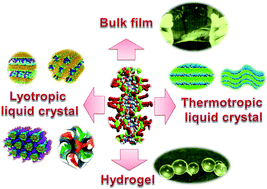当前位置:
X-MOL 学术
›
Chem. Soc. Rev.
›
论文详情
Our official English website, www.x-mol.net, welcomes your
feedback! (Note: you will need to create a separate account there.)
DNA–surfactant complexes: self-assembly properties and applications
Chemical Society Reviews ( IF 40.4 ) Pub Date : 2017-07-07 00:00:00 , DOI: 10.1039/c7cs00165g Kai Liu 1, 2, 3, 4 , Lifei Zheng 5, 6, 7, 8 , Chao Ma 5, 6, 7, 8 , Robert Göstl 9, 10, 11 , Andreas Herrmann 5, 6, 7, 8
Chemical Society Reviews ( IF 40.4 ) Pub Date : 2017-07-07 00:00:00 , DOI: 10.1039/c7cs00165g Kai Liu 1, 2, 3, 4 , Lifei Zheng 5, 6, 7, 8 , Chao Ma 5, 6, 7, 8 , Robert Göstl 9, 10, 11 , Andreas Herrmann 5, 6, 7, 8
Affiliation

|
Over the last few years, DNA–surfactant complexes have gained traction as unique and powerful materials for potential applications ranging from optoelectronics to biomedicine because they self-assemble with outstanding flexibility spanning packing modes from ordered lamellar, hexagonal and cubic structures to disordered isotropic phases. These materials consist of a DNA backbone from which the surfactants protrude as non-covalently bound side chains. Their formation is electrostatically driven and they form bulk films, lyotropic as well as thermotropic liquid crystals and hydrogels. This structural versatility and their easy-to-tune properties render them ideal candidates for assembly in bulk films, for example granting directional conductivity along the DNA backbone, for dye dispersion minimizing fluorescence quenching allowing applications in lasing and nonlinear optics or as electron blocking and hole transporting layers, such as in LEDs or photovoltaic cells, owing to their extraordinary dielectric properties. However, they do not only act as host materials but also function as a chromophore itself. They can be employed within electrochromic DNA–surfactant liquid crystal displays exhibiting remarkable absorptivity in the visible range whose volatility can be controlled by the external temperature. Concomitantly, applications in the biological field based on DNA–surfactant bulk films, liquid crystals and hydrogels are rendered possible by their excellent gene and drug delivery capabilities. Beyond the mere exploitation of their material properties, DNA–surfactant complexes proved outstandingly useful for synthetic chemistry purposes when employed as scaffolds for DNA-templated reactions, nucleic acid modifications or polymerizations. These promising examples are by far not exhaustive but foreshadow their potential applications in yet unexplored fields. Here, we will give an insight into the peculiarities and perspectives of each material and are confident to inspire future developments and applications employing this emerging substance class.
中文翻译:

DNA-表面活性剂复合物:自组装性质和应用
在过去的几年中,DNA表面活性剂复合物作为独特而强大的材料受到了广泛的关注,可用于从光电学到生物医学的各种潜在应用,因为它们具有出色的柔韧性,可以自组装,涵盖从有序层状,六角形和立方结构到无序各向同性相的填充模式。这些材料由DNA主链组成,表面活性剂从DNA主链突出为非共价结合的侧链。它们的形成是静电驱动的,它们形成块状膜,溶致性以及热致性液晶和水凝胶。这种结构的多功能性及其易于调节的特性使其成为在大容量薄膜中组装的理想候选者,例如,可沿DNA主链赋予方向性的导电性,用于染料分散体的荧光猝灭减至最小,由于其非凡的介电性能,使其可用于激光和非线性光学或电子阻挡层和空穴传输层,例如LED或光伏电池。但是,它们不仅充当基质材料,而且本身也作为发色团。它们可用于电致变色DNA表面活性剂液晶显示器中,该液晶显示器在可见光范围内具有出色的吸收率,其挥发性可通过外部温度控制。同时,由于其出色的基因和药物传递能力,使得基于DNA表面活性剂的大体积薄膜,液晶和水凝胶在生物领域的应用成为可能。除了仅仅利用其材料特性外,DNA表面活性剂配合物用作DNA模板反应,核酸修饰或聚合反应的支架时,已证明对合成化学用途非常有用。这些有前途的例子到目前为止还不是很详尽,但是预示了它们在尚未探索的领域中的潜在应用。在这里,我们将深入了解每种材料的特性和观点,并有信心激发使用这种新兴物质类别的未来开发和应用。
更新日期:2017-07-08
中文翻译:

DNA-表面活性剂复合物:自组装性质和应用
在过去的几年中,DNA表面活性剂复合物作为独特而强大的材料受到了广泛的关注,可用于从光电学到生物医学的各种潜在应用,因为它们具有出色的柔韧性,可以自组装,涵盖从有序层状,六角形和立方结构到无序各向同性相的填充模式。这些材料由DNA主链组成,表面活性剂从DNA主链突出为非共价结合的侧链。它们的形成是静电驱动的,它们形成块状膜,溶致性以及热致性液晶和水凝胶。这种结构的多功能性及其易于调节的特性使其成为在大容量薄膜中组装的理想候选者,例如,可沿DNA主链赋予方向性的导电性,用于染料分散体的荧光猝灭减至最小,由于其非凡的介电性能,使其可用于激光和非线性光学或电子阻挡层和空穴传输层,例如LED或光伏电池。但是,它们不仅充当基质材料,而且本身也作为发色团。它们可用于电致变色DNA表面活性剂液晶显示器中,该液晶显示器在可见光范围内具有出色的吸收率,其挥发性可通过外部温度控制。同时,由于其出色的基因和药物传递能力,使得基于DNA表面活性剂的大体积薄膜,液晶和水凝胶在生物领域的应用成为可能。除了仅仅利用其材料特性外,DNA表面活性剂配合物用作DNA模板反应,核酸修饰或聚合反应的支架时,已证明对合成化学用途非常有用。这些有前途的例子到目前为止还不是很详尽,但是预示了它们在尚未探索的领域中的潜在应用。在这里,我们将深入了解每种材料的特性和观点,并有信心激发使用这种新兴物质类别的未来开发和应用。











































 京公网安备 11010802027423号
京公网安备 11010802027423号